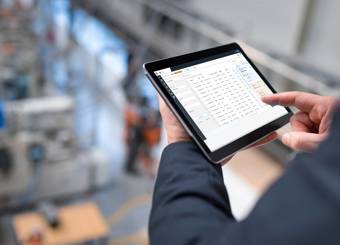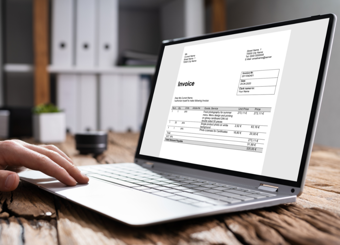What is the full cycle of the accounts payable process? Explaining the full cycle.
Businesses worldwide base their operations on the expenditure cycle and the revenue cycle. The accounts payable process falls under the broader expenditure and purchasing cycle. This workflow includes a range of essential accounting steps needed to complete a purchase when an order is placed and the customer receives the desired product or service, as well as best practices related to those activities.

What is the accounts payable process?

The full cycle of the accounts payable process includes receiving the purchase order (PO) from the procurement team, receipt of the vendor's invoice, cross-referencing the PO with the invoice, and ultimately authorizing the final payment to the supplier. Undertaking these steps is crucial to minimize discrepancies and prevent financial malpractices.
The accounts payable process is only one part of what is known as P2P (procure-to-pay). P2P covers the cycle from procurement and invoice processing to vendor payments.
Get to know the basic accounts payable process
The basic accounts payable cycle includes three significant documents – purchase orders (PO), receiving reports (or goods receipt), and vendor invoices.
To initiate a purchase, the purchasing department of an organization sends a PO to a vendor that includes the requested merchandise, quantity, and price to trigger an order.
Then, when the business receives the goods, a receiving report documents the shipment, including any damages or quantity discrepancies.
The vendor invoice is sent by the vendor to request payment for the goods or services provided. The AP department receives vendor invoices, and the invoice management process begins.
The full flow of the accounts payable process
The accounts payable process is responsible for paying vendors for goods and services purchased by a company. While the complexity of the length of this cycle may differ from one company to the next, the following necessary steps are generally present in some form. The below flowchart demonstrates the full process within an automated AP workflow, once an invoice is received.
Receive invoices from vendors and suppliers
Verify that the invoices are accurate and match the goods or services received
Record the invoices in the company's accounting system
Obtain approval for payment of the invoices
Schedule payments to the vendors or suppliers
Issue payment to the vendors or suppliers either through paper or electronic check, electronic funds transfer, or other payment methods
Update the accounting records to reflect the payment made
Additional AP workflow process considerations
Some companies use vouchers during the approval process. Not all vendor invoices have purchase orders or receiving reports, making the traditional three-way match impossible.
Other payments that may need special verification include monthly payments such as lease agreements and contracts to ensure all payments rendered are legitimate and accurate.
Machine Learning of data capture processes allows your automation system to learn from usual elements of the process and to make meaningful suggestions on how to handle these elements automatically in the future.
Spend and cash flow can vary based on the time of year. Accounts payable automation provides detailed reports to help organizations better manage the full AP workflow when times are tight.
AP automation also facilitates the full-cycle accounts payable process for the highest level of efficiency and accuracy. The savvy use of accounts payable technology (given that it can seamlessly integrate with your ERP) eliminates unnecessary errors, streamlines processes, and helps companies boost their bottom line.
And failing to adopt automation today can mean getting left behind tomorrow.
The importance of an efficient accounts payable process
Although accounts payable is often relegated to the back office, it is business critical. Its efficient operation determines if a company can maintain a timely procure-to-pay process. Consider a few of the benefits that companies receive from giving proper attention to the AP process:
 Financial management
Financial management
Keeping a business fluid is a must in an unstable economy. The wrong move or a disruption in the delivery of goods could send a company spiraling out of control. AP departments ensure that the money flows to business partners in an orderly manner to keep the wheels turning.
 Accurate record-keeping
Accurate record-keeping
Systematic tracking of invoices, goods received, and payments sent ensures that a business is running smoothly.
AP departments that develop a proven process and strive for electronic record-keeping often realize a more efficient audit process.
Paper records are reduced and more easily accessible for future review. Data that is captured electronically can also be shared with other systems or dashboards that keep everyone informed of the current state of affairs.
 Building vendor relationships
Building vendor relationships
Every step that AP staff can take to improve their efficiency and reduce cycle times will influence vendor relationships.
Suppliers appreciate receiving prompt payment for their goods and are more likely to provide better terms during future negotiations.
 Avoiding late fees and penalties
Avoiding late fees and penalties
Developing a tight payment schedule can help a business avoid late fees and may even allow them to take advantage of discounts for early payment.
 Fraud prevention
Fraud prevention
Fraud is a very real threat to businesses. A modern AP process can take advantage of error checking like duplicate payments, invoice mismatches, and alerts regarding unusual patterns to address potential attack vectors.
Challenges in the accounts payable process
The global economy is battering every business. Vendors and suppliers must take steps to protect their interests when entering into contracts for goods or services. This often includes building in late fees or penalties for their partners who are not quick to pay their invoices. Challenges include duplicate payments or double-entry, lost/missing vendor invoices, diluted approval process, inaccurate balance sheet, and late payments and associated fees.
Challenges of a manual accounts payable process
Unfortunately, many businesses still rely on a manual paper-centric AP process. Here are a few of the challenges that arise from failing to update aging accounts payable processes.
- Time-consuming
Manual processes may rely on direct approval from multiple levels of administration. Cycle time increases as invoices must travel to and then be processed by more staff. - Error-prone
AP teams spend a lot of time manually entering data in multiple systems, each with its own format. Data entry errors become more likely, as do misplaced documents that get buried in a pile of paperwork. - Limited visibility
Paper processes are difficult to visualize. It becomes a foregone conclusion that important business decisions will be made on out-of-date and incomplete data. - Difficulty in tracking
Manual payment processing makes it difficult to track the company’s cash flow. Not understanding where every invoice sits increases the likelihood of incorrectly analyzing the company’s financial state. - Inefficiencies
Sorting, organizing, and retaining paper documents makes AP employees waste their time on low-value tasks.Up to 84% of the typical AP staffer’s day is spent on manual tasks according to the Institute of Finance & Management.
The power of automation in AP
AP automation streamlines the steps of the full accounts payable process and ensures a higher level of accuracy throughout every step of the workflow. Automation can reduce manual tasks, streamline invoice approvals, ensure timely payments, and offer insights through monthly reporting.


Accounting software for full cycle accounts payable
The full-cycle AP process is an integral part of a company’s financial statements, and efficiency is required every step of the way. Consider double-entry accounting and how omitting a vendor could lead to two incorrect amounts for two accounts. The ramifications of liabilities and repair (as opposed to prevention through the smart implementation of AP automation) can be costly. Modern digital tools aid the AP process, performing tasks that were once manual and time-consuming. From basic spreadsheets to advanced AP platforms, businesses have a range of options to streamline their operations.
Are outdated processes holding you back?
Accounts payable staff are on the front line of business change and often are tasked to implement cash flow policy changes in near real time. In many ways, AP has become the control tower for managing spend within the organization. However, many of them are stuck with legacy tools and outdated processes, creating massive inefficiencies. The real promise of AI and machine learning within accounts payable is not just streamlining processes but eliminating them. This report from IDC explores how AP automation of today is evolving to become the autonomous AP of tomorrow.

Frequently asked questions about the AP process
The accounts payable process is responsible for paying vendors and suppliers for the goods and services that a company purchases.
AP departments will usually handle incoming bills and invoices and process them for payment. The AP team may have more duties on top of this depending on the size of the company.
The accounts payable process is important for managing a company’s cash flow. Payments must be properly processed in a timely manner to keep the business running at peak efficiency.
Common challenges with the accounts payable process include maintaining separate systems for managing purchasing, invoicing, and payment. Data may have to be entered multiple times, which introduces an opportunity for error.
Manual paper processes add extra time to the cycle time of payment and can negatively impact vendor relationships.
Inefficient methods make it difficult to get a real-time view of a company’s financial health and can lead to poor business decisions.
Automation frees the AP team from manual processes that might steal their time with repetitive or mundane items that could be better spent on high-value tasks.
Digitizing the AP process allows for a faster turnaround from invoicing to payment and gives a company options like discounts for early payment and avoidance of late fees.
Some best practices for managing the accounts payable process include simplifying the workflow through the good use of technology.
Establishing controls and limiting access to financial systems keeps sensitive data safe but still accessible for those that need it.
Reducing verification steps and signature approval responsibilities can drastically reduce the length of the procure-to-payment time.






